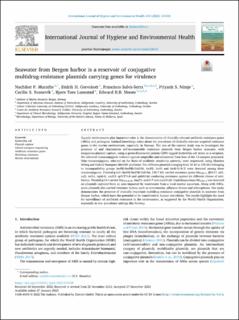| dc.description.abstract | Aquatic environments play important roles in the dissemination of clinically-relevant antibiotic resistance genes (ARGs) and pathogens. Limited knowledge exists about the prevalence of clinically-relevant acquired resistance genes in the marine environment, especially in Norway. The aim of the current study was to investigate the presence of and characterize self-transmissible resistance plasmids from Bergen harbor seawater, with exogenous-plasmid capture, using a green fluorescent protein (GFP)-tagged Escherichia coli strain as a recipient. We obtained transconjugants resistant against ampicillin and cefotaxime from four of the 13 samples processed. Nine transconjugants, selected on the basis of antibiotic sensitivity patterns, were sequenced, using Illumina MiSeq and Oxford Nanopore MinION platforms. Ten different plasmids (ranging from 35 kb to 136 kb) belonging to incompatibility groups IncFII/IncFIB/Col156, IncFII, IncI1 and IncB/O/K/Z were detected among these transconjugants. Plasmid p1A1 (IncFII/IncFIB/Col156, 135.7 kb) carried resistance genes blaTEM-1, dfrA17, sul1, sul2, tet(A), mph(A), aadA5, aph(3″)-Ib and aph(6)-Id, conferring resistance against six different classes of antibiotics. Plasmid p1A4 carried blaCTX-M-55, lnu(F), aadA17 and aac(3)-IId. Cephalosporinase blaCMY-2 was detected on plasmids captured from an area impacted by wastewater from a local marine aquarium. Along with ARGs, some plasmids also carried virulence factors, such as enterotoxins, adhesion factors and siderophores. Our study demonstrates the presence of clinically-important multidrug-resistance conjugative plasmids in seawater from Bergen harbor, which have the potential to be transferred to human microbiota. The results highlight the need for surveillance of antibiotic resistance in the environment, as suggested by the World Health Organization, especially in low prevalence settings like Norway. | |
